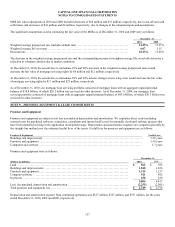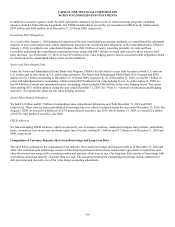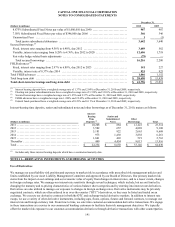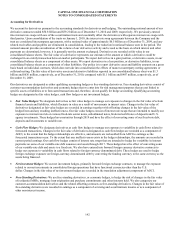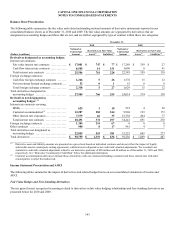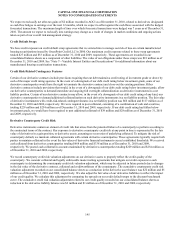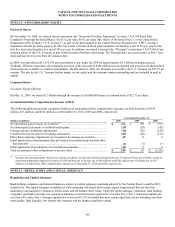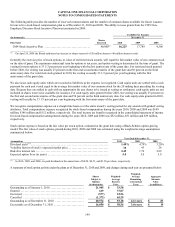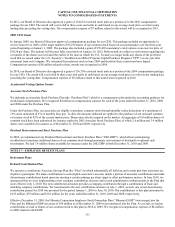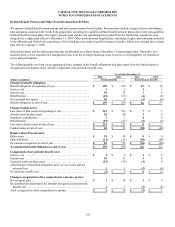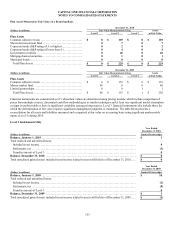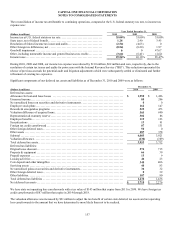Capital One 2010 Annual Report Download - page 167
Download and view the complete annual report
Please find page 167 of the 2010 Capital One annual report below. You can navigate through the pages in the report by either clicking on the pages listed below, or by using the keyword search tool below to find specific information within the annual report.
CAPITAL ONE FINANCIAL CORPORATION
NOTES TO CONSOLIDATED STATEMENTS
147
Under prompt corrective action capital regulations, a bank is considered to be well capitalized if it maintains a total risk-based capital
ratio of at least 10% (200 basis points higher than the above minimum capital standard), a Tier 1 risk-based capital ratio of at least 6%,
a Tier 1 leverage capital ratio of at least 5% and not be subject to any supervisory agreement, order, or directive to meet and maintain
a specific capital level for any capital reserve. A bank is considered to be adequately capitalized if it meets the above minimum capital
ratios and does not otherwise meet the well capitalized definition. Currently, prompt corrective action capital requirements do not
apply to bank holding companies. We are also subject to minimum cash reserve requirements by the Federal Reserve totaling
approximately $915 million as of December 31, 2010.
The table below provides a comparison of our capital ratios as of December 31, 2010 and 2009. As of December 31, 2010, we
exceeded minimum capital requirements and would meet the “well-capitalized” ratio levels specified under prompt corrective action
for total risk-based capital and Tier 1 risk-based capital under Federal Reserve capital standards for bank holding companies. As of
December 31, 2010, the Banks also exceeded minimum regulatory requirements under the OCC’s applicable capital adequacy
guidelines and were “well-capitalized” under prompt corrective action requirements.
December 31,
2010(1) 2009
(Dollars in millions)
Capital
Ratio
Minimum
Capital
Adequacy
Well
Capitalized
Capital
Ratio
Minimum
Capital
Adequacy
Well
Capitalized
Capital One Financial Corp: (2)
Tier 1 risk-based capital(3) ................. 11.63% 4.00% 6.00% 13.75% 4.00% 6.00%
Total risk-based capital(4) ................. 16.83 8.00 10.00 17.70 8.00 10.00
Tier 1 leverage(5) ......................... 8.13 4.00 N/A 10.28 4.00 N/A
Capital One Bank (USA) N.A.
Tier 1 risk-based capital .................. 13.50% 4.00% 6.00% 18.27% 4.00% 6.00%
Total risk-based capital ................... 23.57 8.00 10.00 26.40 8.00 10.00
Tier 1 leverage ........................... 8.29 4.00 5.00 13.03 4.00 5.00
Capital One, N.A.
Tier 1 risk-based capital .................. 11.07% 4.00% 6.00% 10.22% 4.00% 6.00%
Total risk-based capital ................... 12.36 8.00 10.00 11.46 8.00 10.00
Tier 1 leverage ........................... 8.06 4.00 5.00 7.42 4.00 5.00
________________________
(1) Effective January 1, 2010, we are no longer required to apply the subprime capital risk weighting to credit card loans with a credit score equal to
or less than 660. Accordingly, we no longer disclose these ratios.
(2) The regulatory framework for prompt corrective action does not apply to Capital One Financial Corp. because it is a bank holding company.
(3) Calculated based on Tier 1 capital divided by risk-weighted assets.
(4) Calculated based on Total risk-based capital divided by risk-weighted assets.
(5) Calculated based on Tier 1 capital divided by quarterly average total assets, after certain adjustments.
Regulatory restrictions exist that limit the ability of the Banks to transfer funds to us. As of December 31, 2010, funds available for
dividend payments from the Banks were $1.4 billion and zero, respectively. Although funds are available for dividend payments from
COBNA, we would execute a dividend from COBNA in consultation with the OCC. Additionally, a dividend payment by CONA
would require prior approval of the OCC. Applicable provisions that may be contained in our borrowing agreements or the borrowing
agreements of our subsidiaries may limit our subsidiaries’ ability to pay dividends to us or our ability to pay dividends to our
stockholders. There can be no assurance that we will declare and pay any dividends.
The January 1, 2010 adoption of the new consolidation accounting standards resulted in our consolidating a substantial portion of our
securitization trusts and establishing an allowance for loan and lease losses for the assets underlying these trusts, which reduced
retained earnings and our Tier 1 risk-based capital ratio. In January 2010, banking regulators issued regulatory capital rules related to
the impact of the new consolidation accounting standards. Under these rules, we are required to hold additional capital for the assets
we consolidated. The capital rules also provided for an optional phase-in of the impact from the adoption of the new consolidation
accounting standards, including a two-quarter implementation delay followed by a two-quarter partial implementation of the effect on
regulatory capital ratios.
We elected the phase-in option, which required us to phase-in 50% of consolidated assets beginning with the third quarter of 2010 for
purposes of determining risk-weighted assets. However, the phase-in impact was effectively accelerated over the first three quarters of
2010 due to pay downs of outstanding securitization debt. The phase-in provisions expired after December 31, 2010, and the full
impact of the consolidated assets on our capital ratios will be realized in the first quarter of 2011.


